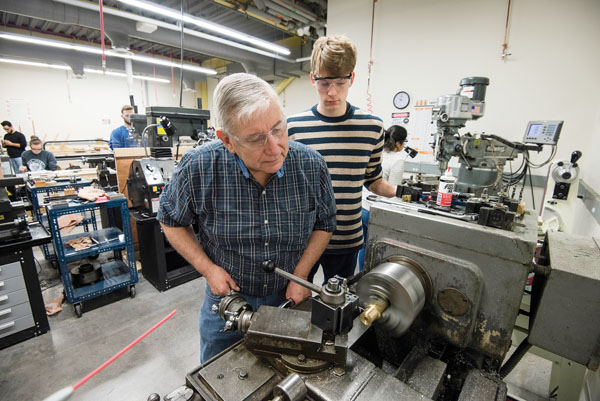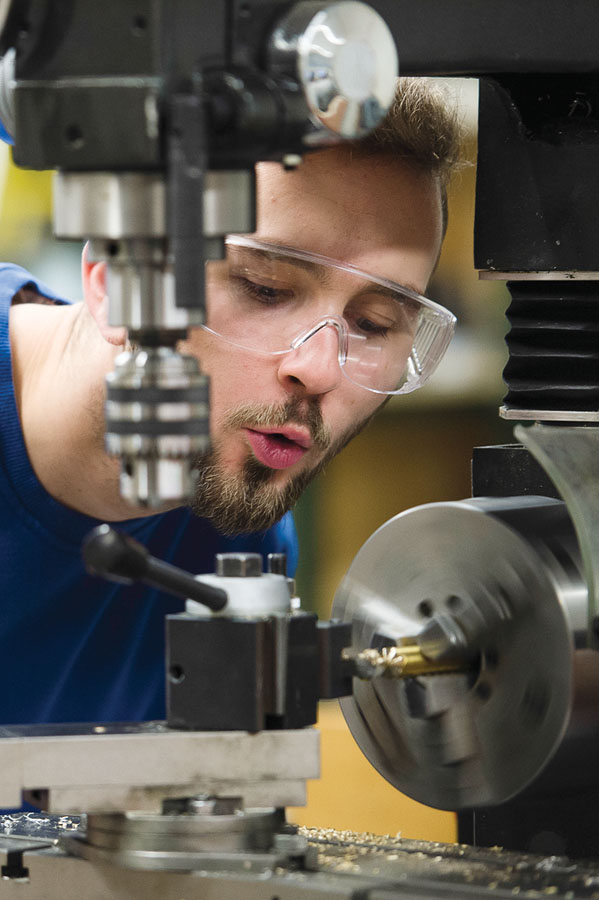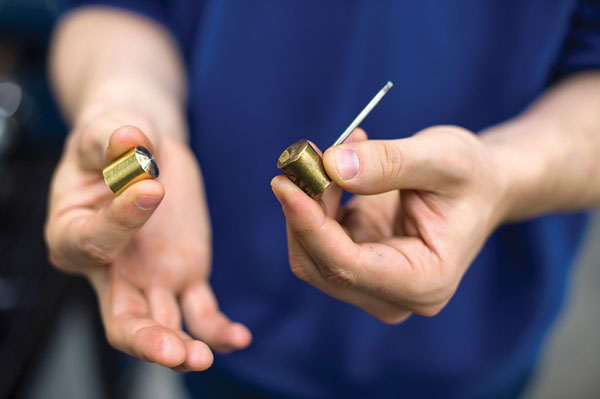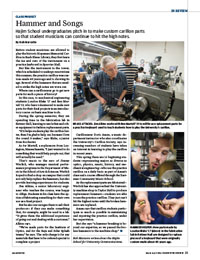In Review
 BRASS ATTACKS: Jim Alkins works with Ben Martell ’19 to mill brass replacement parts for a practice keyboard used to teach students how to play the University’s carillon. (Photo: Adam Fenster)
BRASS ATTACKS: Jim Alkins works with Ben Martell ’19 to mill brass replacement parts for a practice keyboard used to teach students how to play the University’s carillon. (Photo: Adam Fenster)Before student musicians are allowed to play the historic Hopeman Memorial Carillon in Rush Rhees Library, they first learn the ins and outs of the instrument on a practice keyboard in Spurrier Hall.
But like the instrument in the tower, which is scheduled to undergo renovations this summer, the practice carillon was custom-made 40 years ago and is showing its age. Several of the hammers that are needed to strike the high notes are worn out.
Where can a carillonneur go to get new parts for such a piece of history?
In this case, to mechanical engineering students Loudon Blake ’17 and Ben Martell ’19, who have volunteered to make new parts for their final projects in an introductory course on basic machine tools.
 HAMMER HELPER: New parts made by Loudon Blake ’17 in the fabrication lab in Rettner Hall are designed to replace pieces of a keyboard (below) that were originally custom made about 40 years ago. (Photo: Adam Fenster)
HAMMER HELPER: New parts made by Loudon Blake ’17 in the fabrication lab in Rettner Hall are designed to replace pieces of a keyboard (below) that were originally custom made about 40 years ago. (Photo: Adam Fenster) (Photo: Adam Fenster)
(Photo: Adam Fenster)During the spring semester, they are spending time in the fabrication lab in Rettner Hall, learning to use lathes and other equipment to fashion replacement parts.
“If it helps students play the carillon better, then I’m glad to help out, because I love the sound it makes,” says Blake, a junior from Rochester.
As for Martell, a sophomore from Lexington, Massachusetts, “I just wanted to do something that would help people out, that will actually be used.”
That’s music to the ears of Jimmy Warlick, who manages musical performance programs in the Department of Music in the School of Arts & Sciences. Warlick hoped to find a shop on campus that could not only help replace the hammers, but also provide learning experiences for students.
Jim Alkins, a senior laboratory engineer who teaches the course, was happy to oblige. Students in his class have the option of fabricating something for their own use as a final project.
But he also encourages them to ask their professors if they can make something that, for example, might be used in a lab. “It gives them the additional experience of going out and dealing with a customer,” Alkins says.
“We’ve made parts for the Institute of Optics, and for the Baja and Solar Splash teams,” he says. The only charge is for any materials that have to be ordered special to complete a project.
Carillonneur Doris Aman, a music department instructor who also coordinates the University’s Carillon Society, says increasing numbers of students have taken an interest in learning to play the carillon in recent years.
This spring there are 13 beginning students—representing majors as diverse as optics, physics, music, history, and mechanical engineering—who use the practice carillon on a daily basis as part of Aman’s class and a course offered through the Eastman Community Music School.
As the replacement parts are fabricated—Warlick has also approached the University machine shop in Taylor Hall to produce replacement hammers—students are able to use the practice carillon. They just can’t hit the highest notes until the broken hammers are replaced.
Aman says that carillon students participate as much as possible in maintaining and repairing the practice carillon, under her supervision.
But she says “a hammer breaking is beyond our expertise, so we passed the broken hammers to the machine shop.”
Bob Marcotte writes about the Hajim School for University Communications.

